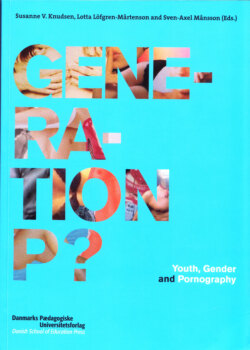Читать книгу Generation P? - Группа авторов - Страница 14
На сайте Литреса книга снята с продажи.
The failure of sexual education
ОглавлениеSince the liberalisation of laws pertaining to pornographic pictures, sexual education has done a lot to teach children and adolescents about pornography and not least how to differentiate between fantasy and reality. As one of the first to discuss this topic in Denmark, Preben Hertoft, professor of sexology, wrote in his book of sex education Du og det andet køn (You and the opposite gender) from 1973:
In pornography sexual activities are described as rather isolated from life as a whole and they therefore appear with a very mechanical and demonstrative imprint. Thus, pornography becomes quite detached from reality. It certainly pretends to describe sexual relations as ‘they really are’, but the result is usually portrayals that have little in common with reality. It is necessary to notice this quality of unreality (…) in order not to believe that pornographic descriptions can be used as manuals for how to live life itself (My translation).
In his book Køn, krop og kærlighed (Sex, body and love) twenty years later (1992) Preben Hertoft repeatshis point of view (Hertoft 1992). As in many other sex education books from the early 1990s Hertoft includes whole sections that exclusively deal with pornography. This is also the case in Alex Nyborg Madsen’s formidable Tænd lyset (Turn on the light) from 1995. However, very few writers include a gender perspective or strive to make boys and girls aware of how gender is portrayed in pornography.
In the most recent Danish sex education literature for children and adolescents pornography as a specific topic has undergone a tremendous change. However, the new role that pornography plays in our culture is not discussed. Generally, pornography is mentioned in an isolated sentence here and there in connection with other topics, if mentioned at all. In those cases where the authors give pornography priority, they do so with the ’Hertoftian’ endorsement, that ’pornography must not be mistaken with reality’. This is for example the case with Janne Hejgaard’s latest publication Kys og bolle (Kisses and cuddling) from the year 2000, in which she gives advice on, among other issues, what to do when one is ’uncertain and fumbling’:
First of all you have to gain knowledge. Read books, talk with someone, watch a film (an educational film that is, not a porn video, they do not deal with reality, but is more like sexual fairytales) (My translation).
Janne Hejgaard’s material is interesting because it reflects a culture which is accustomed to pornography and expects young people to know of and to watch pornography as a matter of course. The stance that Hejgaard seems to take is that for this reason there is no point in delving deeper into the topic. Her presupposition about access to pornography becomes a symptom of the position porn has in our culture at this time: a liberated, omnipresent factor which is hard to see as a problem. However, in her understanding of pornography as omnipresent and her consequential fear of being didactic Hejgaard’s coverage becomes painfully insufficient as well. It may seem legitimate to skim the topic, but more than ever there is a need for specific prioritization which shines light on and discusses the cultural status of pornography, mass culture’s porn chic tendencies and not least the gender representations that are transmitted to our culture. If this is done, it may be possible for children and adolescents to place regular pornography where it belongs, and more importantly to place themselves – their sexual identity and sexual understanding – in relation to the pornographic universe. In this connection it must be mentioned that the Danish organisation Sex & Samfund (Sex & Society) in the spring of 2002 published the book Parat til sex – om unges seksuelle adfærd (Ready for sex, about adolescents sexual behaviour)(Aaen et al. 2002). This book is intended to inspire teachers and other educators and furnish them with ideas about how to teach sexual education. It contains an excellent chapter about pornography written by the Danish researcher Rune Gade.
